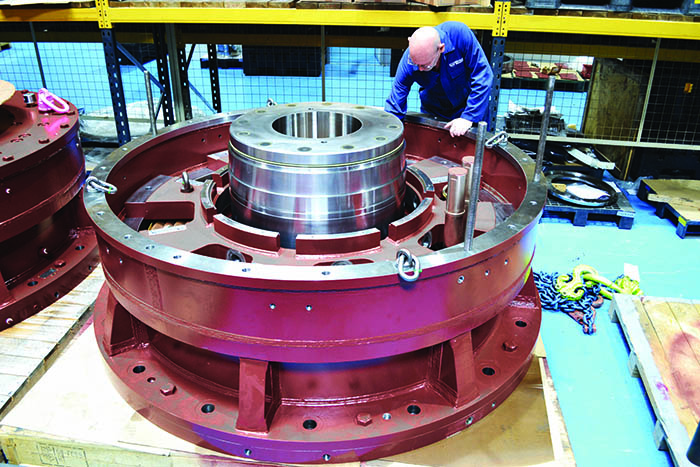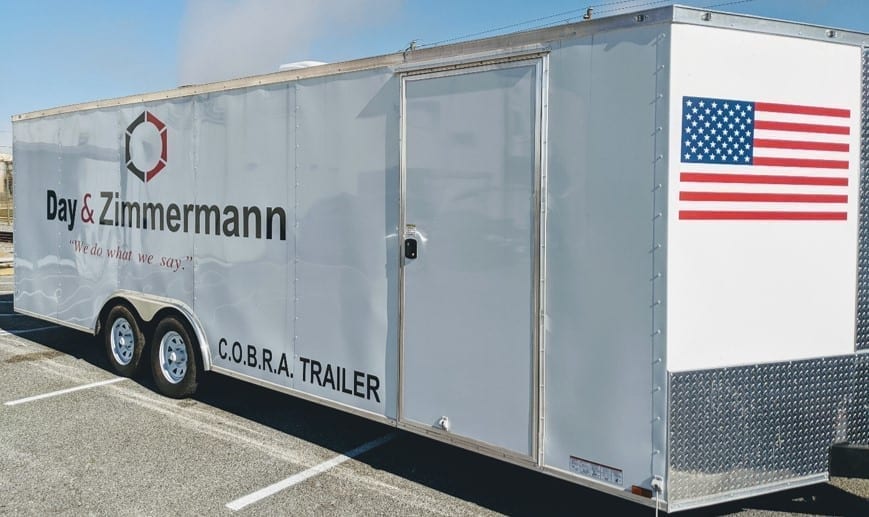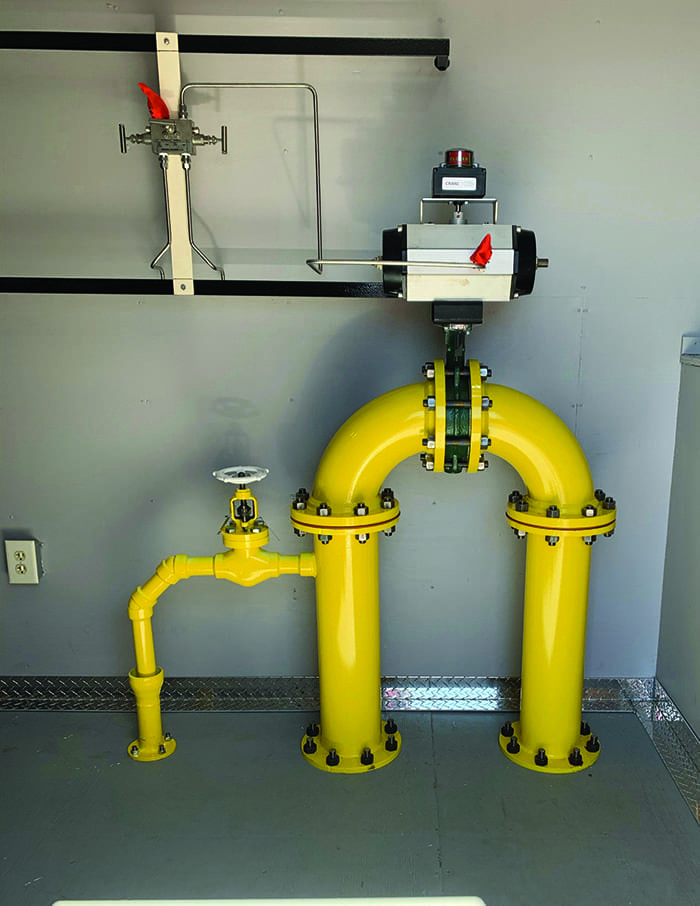Advanced Technology, Innovative Solutions Enhance Nuclear Operations and Maintenance
The post Advanced Technology, Innovative Solutions Enhance Nuclear Operations and Maintenance appeared first on POWER Magazine.

Incorporating new technology and solutions being used by others could help nuclear power plant staff improve operations and maintenance practices.
Nuclear power plants face many challenges. Monitoring heat exchangers for signs of trouble, upgrading pump bearings to minimize the likelihood of failure, and improving human performance are just a few examples of actions that could enhance operations and maintenance (O&M) at nuclear facilities.
Eddy Current Testing EvolvesOne nuclear power plant component that has required a lot of attention over the years is the steam generator in pressurized water reactor (PWR) units. Steam generators separate the primary water circuit from the secondary water circuit. In PWRs, pressurized primary water, which is radioactive, is pumped through the reactor to remove the heat generated by fission of uranium fuel in the core. The heat is transferred to the non-radioactive secondary water system through thousands of tubes in the steam generator, producing the steam used to drive turbine generators to produce electricity.
Steam generators can be up to 70 feet tall and have as many as 16,000 three-quarter-inch-diameter tubes. The problem with many original designs was that the tubes were not robust enough to withstand the harsh conditions they encountered. Most U.S. steam generators were made with Alloy 600 tube material, a nickel-chromium-steel alloy that proved to be susceptible to thinning under some water chemistry programs.
Tube denting also became a concern over time. Denting is caused by corrosion on carbon steel support plates in the generators, and in the crevices between tubes and the tube support plates. There were also other causes for tube cracking, leaks, and ruptures in PWR plants with mill-annealed Alloy 600 tubes.
A common way to monitor steam generator tube condition is through eddy current testing. Eddy current technology provides a fast and efficient solution for detecting near-surface anomalies in conductive material. A magnetic field from a coil is induced into the tube material. Anomalies in the material create changes to the eddy currents that are sensed by specialized instrumentation and then evaluated by well-trained experts.
The technology was first developed in the 1930s, but has evolved greatly since that time. Zetec, a global provider of nondestructive testing (NDT) technology, has been supplying eddy current testing instruments, probes, software and services for more than 50 years. The methodology and the actual science, and the physics, of course, hasn't changed, but the delivery and analysis systems have improved tremendously," said Kevin Newell, manager for Zetec's RevospECT Group. Newell noted that the speed of eddy current operations has increased well over tenfold since he began working in the field in 1983.
Analyzing the data has also evolved since Newell started. Certain tasks that once required a trained technician can now be done using computer programs. You basically set up a routine for the computer to go through and look at all these signatures, and you train it to recognize what are normal signatures and what are abnormal signatures," Newell said. The final analysis is confirmed by an expert, but the data screening performed by the automated system is invaluable.
We're just embarking on adding now some very focused machine learning attributes," said Newell. He noted that computers will often identify false positives," that is, anomalies that look like potential issues, but aren't actually problems. That has to be sifted through," he said. Machine learning helps eliminate those false positives."
Of course, all of the data is ultimately important for trending purposes. We have literally decades of information now, if a plant is still operating, where we have that initial inspection, and we can see how the tubes changed over time. And that's where our program of historical data compare comes into play," said Newell.
Many of the original steam generators have been replaced today. Most have been upgraded to thermally treated Alloy 690 tube material, which is better at resisting corrosion and has not demonstrated the same propensity for cracking as Alloy 600. Newell said that has caused a shift in Zetec's focus.
Now, all of a sudden, from the steam generator perspective, those teams have shrunk, because they're just not having those problems as they did before," he said. These days, balance-of-plant components have become more of an emphasis, that is, feedwater heaters, lube oil coolers, main and auxiliary condensers, and other heat exchangers. That focus has shifted, and those are now pretty large inspections, with a lot of personnel, so that's where we've transitioned our steam generator technology into the balance-of-plant operations," Newell said.
Better Reactor Coolant Pump BearingsReactor coolant pump bearings aren't as prone to failure as steam generator tubes, but when a station blackout (SBO) occurs and pumps run down without power, it can pose significant challenges for these hydrodynamic bearings. Michell Bearings, a UK-based bearing designer and manufacturer, has recently completed successful SBO tests on a thrust bearing for a new-build nuclear plant. In what the company claims is one of the world's first successful bearing tests without the use of any externally powered auxiliary systems, the innovative bearing was able to survive the SBO condition.
The challenge for us was to be able to design the bearing in such a way that it could safely run down from full speed to rest whilst supporting quite challenging loads, and then restart again without sustaining damage in the process," explained Geoff Humble, sales and marketing director with Michell Bearings.
The company conducted the testing on two separate projects involving vertical cooling water pumps. One test involved bearings positioned in the pump motor. In that case, there was a thrust bearing on the top of the machine and a radial bearing on the bottom of the machine. The other test involved a thrust bearing positioned in the pump (Figure 1). It doesn't matter to us where the bearing is sited. That's a decision that the machine manufacturer makes," Humble said.
 |
1. UK-based Michell Bearings designs and manufactures bearings for reactor coolant pumps and other machines. The vertical bearing shown here is representative of the type used in some nuclear applications. Courtesy: Michell Bearings |
In the testing, the segmented tilting pad thrust bearing was the critical component. This is the bearing which is supporting axial loads in both directions, upwards and downwards," he said. At rest, the weight of the machine applies downward force on the bearing. During operation, the predominant thrust is upward; therefore, the net load takes the weight off the lower thrust pads and applies a much greater force to the upper thrust pads.
In the normal mode of operation, we have an external-powered high-pressure oil source, which is used to separate the bearing surfaces by physically forcing the shaft from the pads," explained Humble. Obviously, during a station blackout condition, the external pump motor system which is supplying that high-pressure oil is electrically powered and therefore not able to function."
Engineers started with Michell Bearings' conventional thrust bearing and conducted pilot testing on lab-scale models to refine the design, which was then scaled up to a full-size machine for subsequent testing. Finally, they proved the design using both an in-house test rig and at the European customer's testing facility. In both cases, the company was able to satisfy the SBO requirements through multiple starts and stops.
The bearings can be used in both new-build and retrofit applications. In fact, Humble said the company has already supplied parts to at least one European customer for use in an existing reactor coolant pump, and Michell Bearings is developing a complete bearing of its own for future machines.
Improving Human PerformanceOf course, not all O&M issues are equipment related. There are plenty of nuclear plant problems that result from human performance errors, so getting people to focus on safe and sound work practices can go a long way toward improving operations.
We're in the people business," said Bill Hickman, vice president of nuclear operations with Day & Zimmermann (D&Z), a family-owned company that specializes in construction and engineering, operations and maintenance, staffing, security, and defense solutions. Hickman explained that D&Z provides skilled resources to help with maintenance and modifications at more than half the nuclear units in the U.S.
Our clients expect us to score every time we take the field," Hickman said, using a sports analogy to drive home the point that D&Z's customers demand high-quality results. For sites that use union labor, D&Z works closely with local Building Trades to source workers for jobs. The halls use apprenticeship programs to train their craft and provide a lot of good talent," Hickman said. But even the most talented craft worker can use the occasional refresher, so we looked into how we could provide additional and ongoing training to help keep the crafts' skills sharp and continue to meet our customers' expectations."
After assessing a variety of options, the idea for a Craft On-Boarding Ranking Assessment (COBRA) trailer was born (Figure 2). Our assessment process helps us understand what each worker is capable of doing and identify any gaps that we could address," said Hickman. And so, we built three of these trailers."
 |
2. Day & Zimmermann constructed three Craft On-Boarding Ranking Assessment (COBRA) trailers to provide additional training for craft workers. Courtesy: Day & Zimmermann |
The tasks incorporated into the COBRA trailer assessments (Figure 3) are based on feedback from work supervisors. Hickman asked supervisors where they were having the most problems, and then created training and evaluation activities to address the issues. Among the jobs included are lifting and landing electrical leads, plugging condenser tubes, torquing flanges, working on instrumentation equipment, and repairing valves. Hickman noted that the trailers are flexible, and items can be swapped out as weaknesses become strengths and new issues are identified.
 |
3. The COBRA trailers allow hands-on experiences in a simulated environment where workers can be trained and evaluated on a variety of tasks. Courtesy: Day & Zimmermann |
We feel like the trailers have really helped us, because our quality has gotten better and there are less mistakes in the field," he said. Now, it's slowed down to a point that our rework is little to nothing."
According to Jason Dunaway, president of union operations with D&Z, the company's ability to share lessons learned across the entire fleet of plants it works with is invaluable too. We keep data-we keep intelligence-that we share with each of our individual clients," Dunaway said. But we can take the data intelligence we're learning across our fleet, and apply that to certain areas. If someone's operating better in one part of the country, we can take that learning, and communicate that news at another utility or with another client."
Dunaway said D&Z was involved in almost 80 planned outages in 2020, plus additional forced outages and other maintenance projects, so it deals with a lot of different procedures and processes. It knows what works well and what doesn't. Not everyone's going to treat things exactly the same way. There are site-specific challenges that need to be addressed, and some utilities approach things a little bit differently, but we share all the best practices while maintaining our customers' confidentiality," said Dunaway. In the end, learning from others' mistakes is never a bad thing.
-Aaron Larsonis POWER's executive editor.
The post Advanced Technology, Innovative Solutions Enhance Nuclear Operations and Maintenance appeared first on POWER Magazine.